Are you ready for a life free from glasses and contact lenses? Vision Correction has experienced numerous technological advances and there are more procedures to fit more eyes than every before. We believe in the importance of you fully understanding
The eye is like a camera. A camera uses lenses to focus light onto film and our eyes use lenses (the cornea and the lens) to focus light onto the retina. The retina is similar to film in that it’s the light-sensing part of the eye that sends the images to the brain.

For the retina to send images to the brain, the need to be clear and in focus. Unfortunately, not everyone is born with an optical system (cornea + lens) that clearly focuses light on the retina. Emmetropia refers to an eye naturally focuses light clearly on the retina. These people do not need vision correction. Refractive Error refers to the condition where light rays do not focus on the retina. Myopia (nearsightedness) refers to when the light rays are focused in front of the retina either because the optical system is too powerful (too much focusing power) or the eye is too large for the optical system. People with myopia can still see up close which is why it’s also called nearsightedness. Hyperopia (farsightedness) refers to when the light rays are focused behind the retina either because the optical system is too weak (too little focusing power) or the eye is too short for the optical system. Because our natural lens can change focus (to help us see up close) we can naturally overcome some hyperopia and see clearly without glasses, contact lenses, or vision correction. People with myopia or large amounts of hyperopia will need help to see clearly far away. Fortunately, glasses and contact lenses are not the only answer!
As we age, the clear lens we’re born with starts to become cloudy. Certain diseases can make this process happen faster, like diabetes. A cloudy lens is called a cataract. Like the Cataract Hotel in Niagra Falls or the Old Cataract Hotel in Egypt, cataract also means “waterfall.” Unlike smooth water, water moving over a waterfall is white and difficult to see through, just like a cataract. There are different types of cataracts but they are all treated essentially the same.
Instead of focusing light on the retina like a clear lens, a cataract scatters light and causes glare and blurry vision.
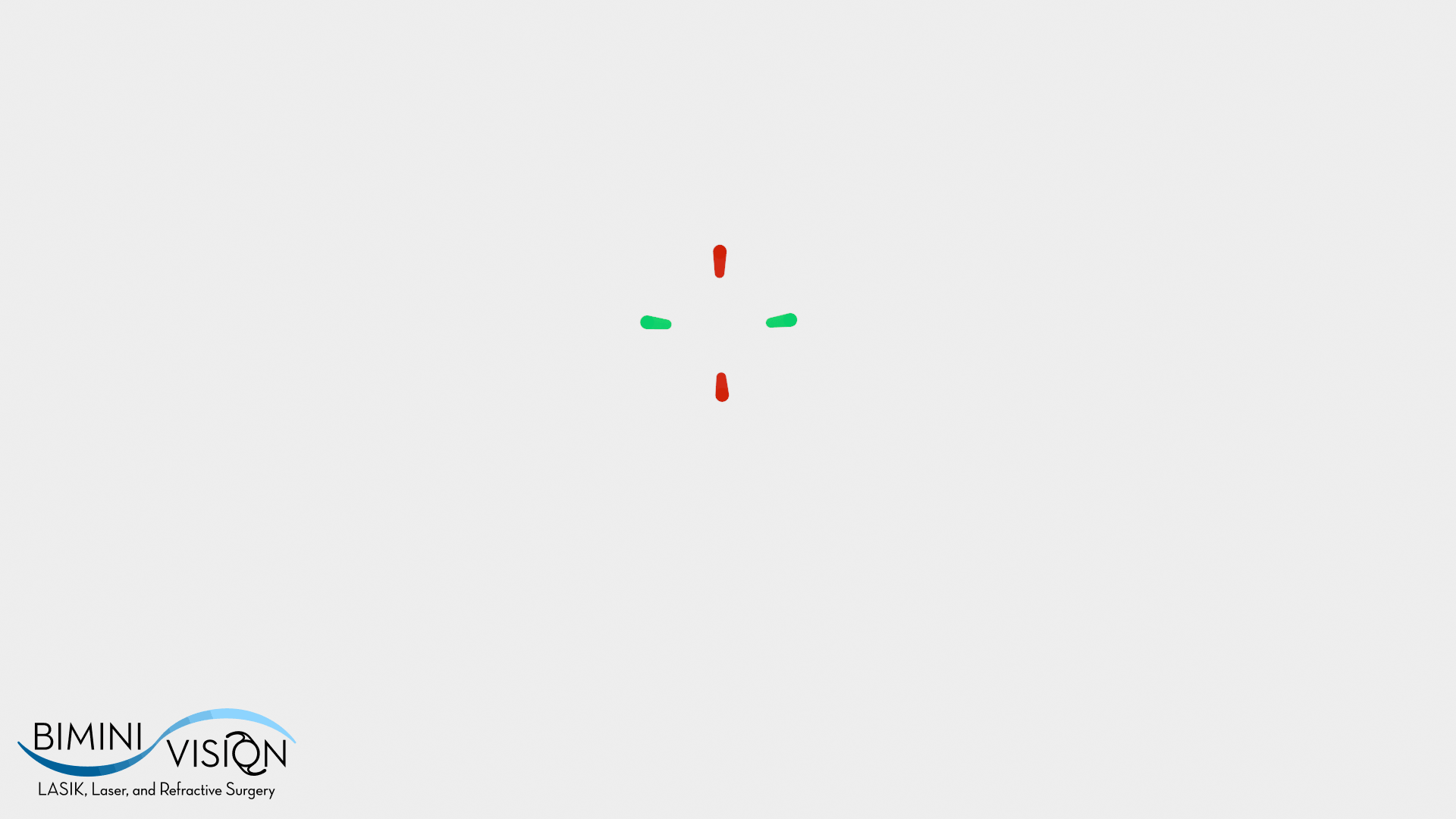
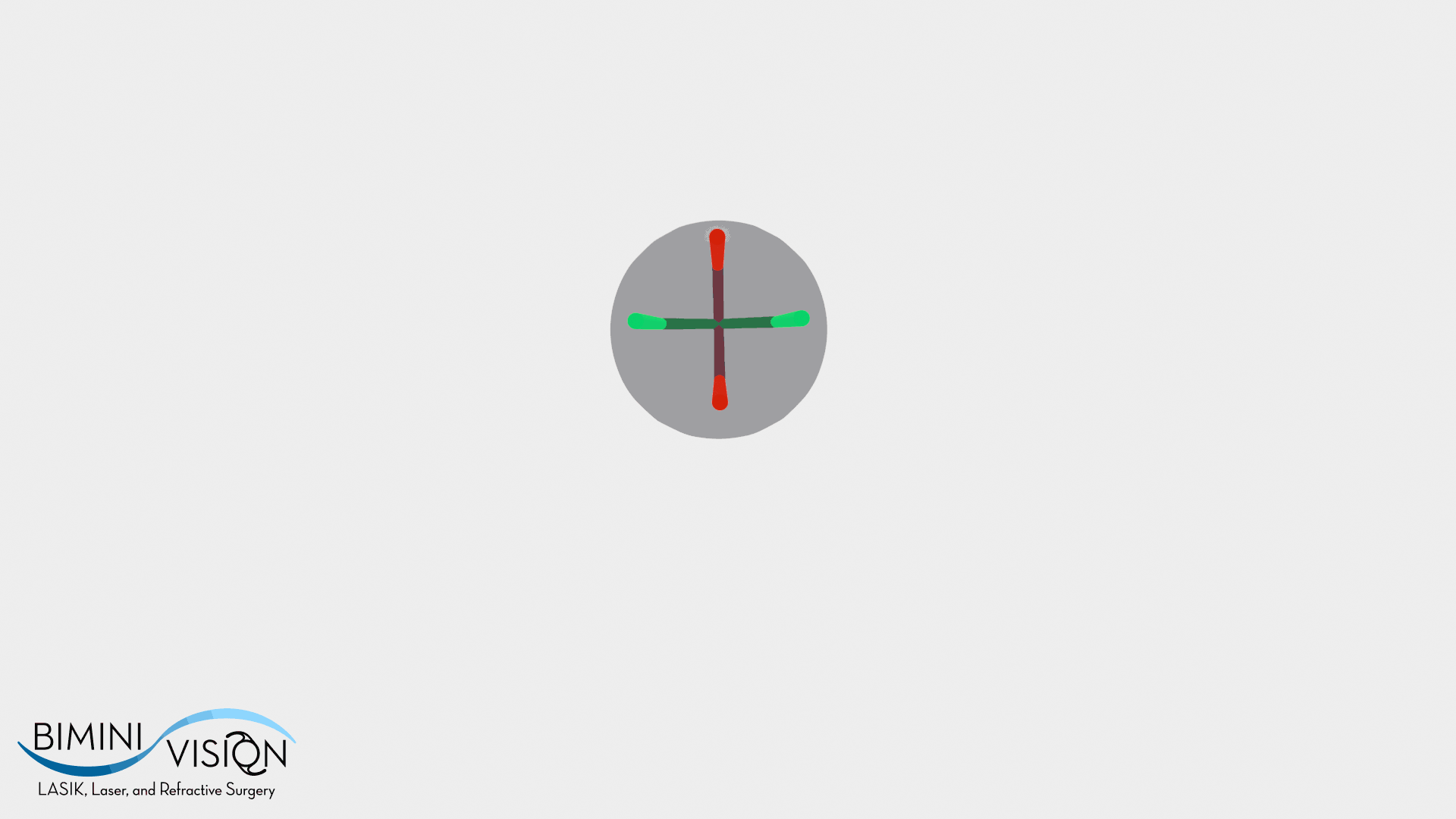
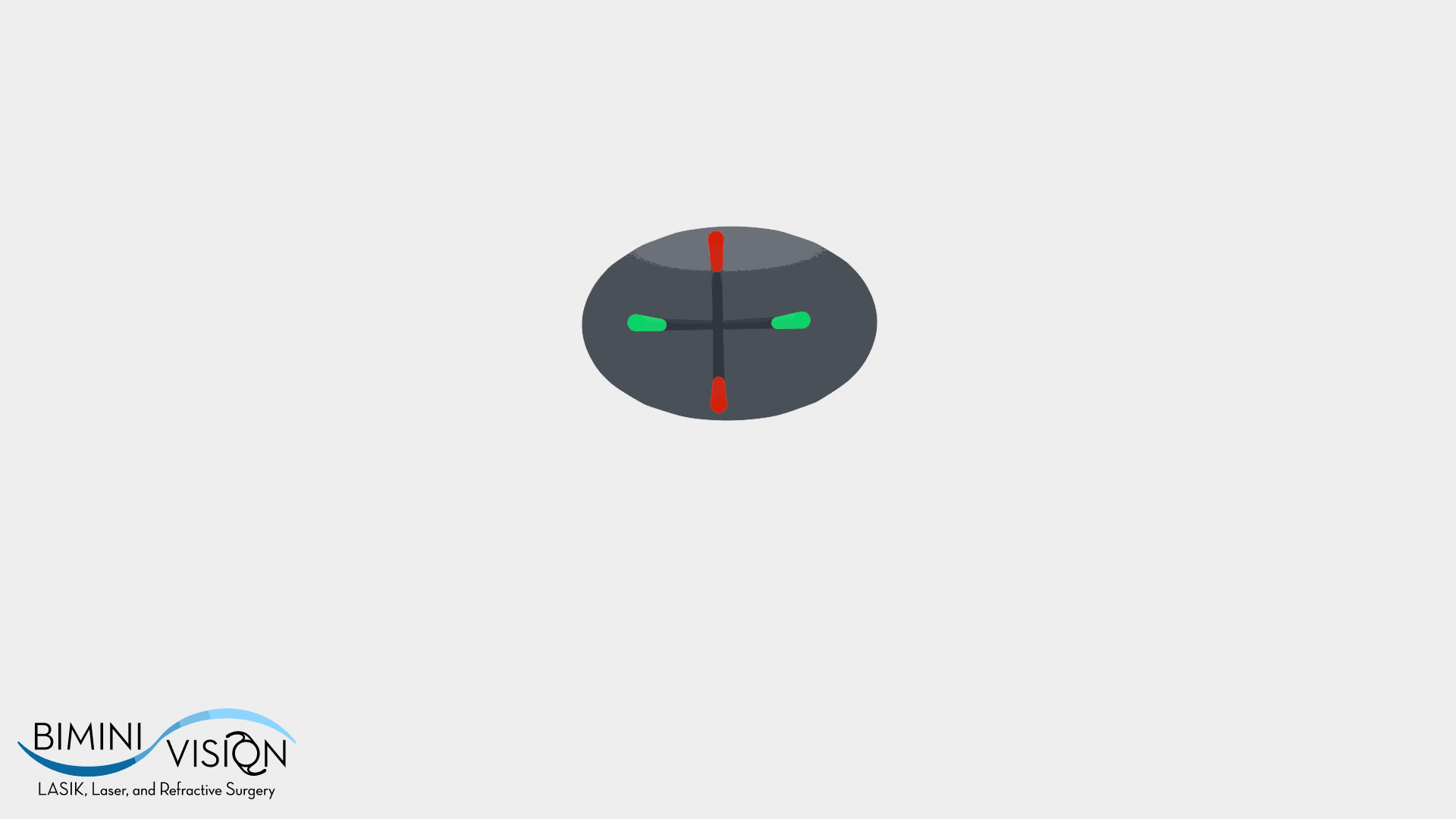
Notice in the Astigmatism animation, the red and green light rays are no longer focusing in the same place because they are experiencing different amounts of curvature when passing through the cornea with astigmatism. It’s the fact that these light rays don’t meet in the same place that causes the blurry vision the comes with astigmatism. One important caveat is that we have described regular astigmatism. Even though the two sets of light rays aren’t focusing in the same place, the astigmatism still treatable. Irregular astigmatism, while rare, is little more complicated and not easily treatable. Examples of conditions that may cause irregular astigmatism include but are not limited to keratoconus, corneal scars, or corneal dystrophies. Your surgeon will carefully study your measurements to make sure you have the treatable, regular astigmatism we have discussed here.
A very important consideration for vision correction is your Ocular Milestone. Our eyes changes with us throughout our lives. The Ocular Milestones describe the different stages of our eyes. The Ocular Milestones each have a set of Vision Correction procedures that best treat the eye at their different stages. There are Vision Correction solutions for every age! The ages are approximate and every eye is unique. Some may progress through the Ocular Milestones earlier or later than others. The important part is discerning which Ocular Milestone your eyes are currently in to determine the best Vision Correction plan.
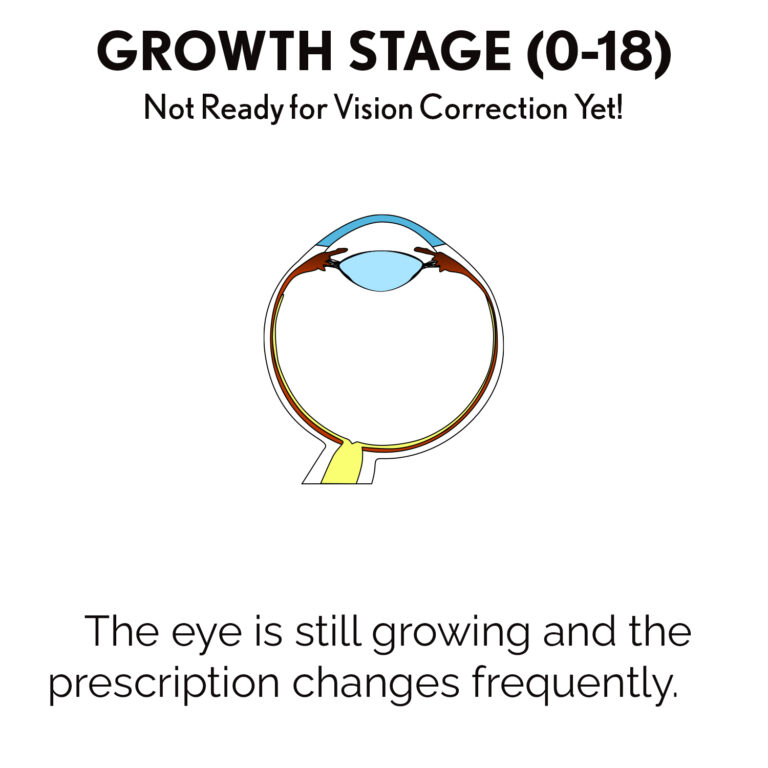
The eyes grow with us! When we’re born, our eyes are about 2/3rds the size they will be as adults. As the eyes grow, our prescription changes frequently so Vision Correction at this stage wouldn’t be practical. We will carefully check your eyes and make sure they are no longer changing before your procedure.
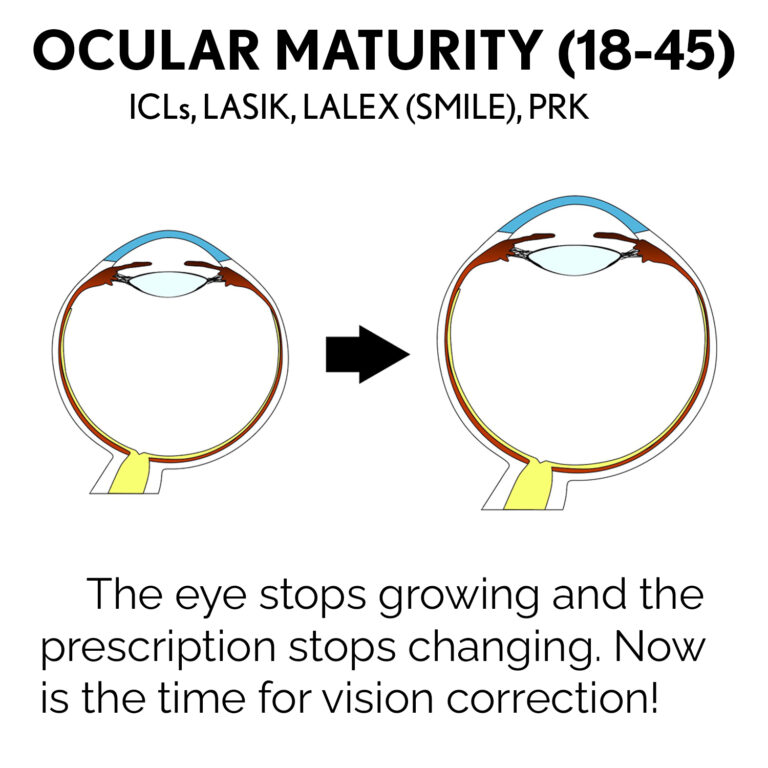
Around age 18, the eyes stop growing and the prescription stabilizes. Don’t worry... we will check to make sure your prescription isn’t changing anymore. At this stage, you’re ready for Vision Correction! There are many procedures available for this Ocular Milestone which we will discuss shortly.
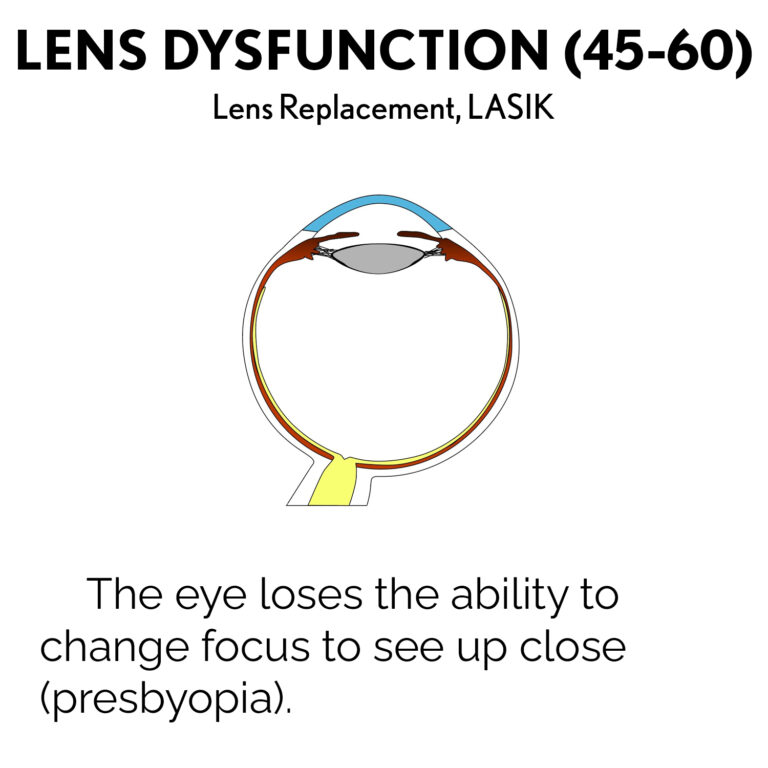
In our 40s, the natural lens loses its ability to change focus. Having a dysfunctional lens is called "presbyopia" and many people either turn to reading glasses or need to take their glasses off in order to see up close. While presbyopia never gets better on its own, there are ways to remain free from glasses at this stage.

The natural lens continues to harden and becomes cloudy with age. This can cause blurry vision, halos around lights, and glare. Some conditions like diabetes can accelerate this process. For more detailed information about cataracts and cataract surgery, please follow the link below.
Every eye is unique! On the day of your appointment, you will be greeted at the front desk and using information from the account you created when making the appointment, we can skip most of the paperwork and registration.
Our skilled team will perform a series of measurements on your eyes before checking your current vision and prescription. You will be dilated but don’t worry, we will “un-dilate” you before you leave. After reviewing your scans, either Dr. Hirabayashi or Dr. Virdi will examine your eyes and talk to you about the lens and surgery options.
The measurements we take are heavily influenced by the health of your tear film (the layer of tears that covers the front of your eye). You can help us by optimizing your tear film. How do you do this? Use preservative free artificial tears at least 4 times a day the two weeks before your consultation. These can be purchased at most drug stores. You can also run a washcloth under warm water and apply it to your eyelids for 15 minutes every night to keep your eyelids healthy. These small steps don’t just feel good, they also help make your cornea healthy to ensure we obtain the most accurate measurements possible.
If you wear contact lenses, this can also affect the quality of these measurements. Please stay out of your contact lenses for at least 7 consecutive days before your consultation. If you wear rigid or hard contact lenses, several measurements might be necessary to ensure the best possible outcome.
After developing a plan, you will speak to our surgery schedulers so you can start counting down to the big day!
There are many different Vision Correction procedures available today that fit each ocular milestone and almost every type of eye and refractive error. With so many modern technologies, the variety of procedures can be intimidating but here is an explanation of the procedures. We will take great care to examine and measure your eyes to find which procedure would be best for you. Unfortunately, Vision Correction is not covered by insurance but we have priced the procedures to remove as much of the financial element from the decision making process as possible.
Our Vision Correction packages include our “On-Target” promise. This means if for some reason, the outcome isn’t what we expected, we’ll work with you to make it right.

ICLs (intraocular contact lenses) are an incredible way to correct vision and provide some of the best results possible. They are branded as the EVO Implantable Collamer® Lens (ICL). Unlike other vision correcting procedures, these are essentially contact lenses that rest behind the color portion of your eye (the iris). They are invisible to others and are great for those with prescription more than around -3.00D of nearsightedness and also treat astigmatism. They also may be the perfect option for those who aren’t good candidates for LASIK. Visual recovery is almost immediate after surgery. ICLs can give you better vision than LASIK and are often the best choice for those that are very nearsighted.
ICLs are unique because they’re completely reversible as an additive technology. Instead of changing the anatomy of your eye, the lens is added and can easily be removed for any reason.
ICLs also have some of the fastest visual recovery of any vision correction procedure. Many people see better immediately or within the first hour after surgery!
We take all the measurements we need for any vision correction procedure at your consultation. It’s important to stay out of soft contact lenses for at least five (5) days and three (3) weeks for rigid contact lenses. If you have special contact lenses, let us know when you schedule your consultation. We can operate on the same day as your consultation with proper planning.
We take great care to make sure there is no discomfort at any point of the procedure. We make two very small openings in the cornea (the clear part at the front of the eye), fold the ICL, and insert it behind the iris and in front of your natural lens. Both eyes are completed on the same day and the procedure itself usually takes about 10 minutes.

After the procedure, you will have drops to take and will need to take it easy for a week. This means no lifting, straining, submerging your head in water, or touching/rubbing your eyes. We will see you one day, one week, and one month after surgery. take just one eyedrop over the next month to help your eye heal. If you use our VIP iOS app, you can receive reminders and/or easily track your drop schedule. Generally, plan to use the eyedrops 4 times a day for the first week after surgery, 3 times a day for the second week after surgery, 2 times a day for the third week after surgery, and 1 time a day for the fourth week after surgery.
It is very common to see rings of light for the first few weeks after the procedure. These rings naturally disappear in the vast majority of people. For example, Dr. Hirabayashi has ICLs! He saw rings when point sources of light were in his visual field (like headlights when driving at night) and has provided an illustration of what they look like below. After a week, he no longer could notice the rings except very rare circumstances with headlights at night. Even then, they are very brief and do not impact vision in any way.
This is a digital rendering by Dr. Hirabayashi of the temporary rings that he saw after his ICL procedure. These dissappeared over the following week.


LASIK (Laser in-situ Keratomileusis) uses a laser to reshape the cornea (the clear, front part of the eye) so it can better focus light onto the retina. LASIK first creates a flap that is lifted out of the way of the laser and then put back into place after the cornea is reshaped.
We take all the measurements we need for any vision correction procedure at your consultation. It’s important to stay out of soft contact lenses for at least five (5) days and three (3) weeks for rigid contact lenses. If you have special contact lenses, let us know when you schedule your consultation. We can operate on the same day as your consultation with proper planning.
We take great care to make sure there is no discomfort at any point of the procedure. For LASIK, the first step is creating the flap. We then move to another machine that has both the LASIK and PRK lasers. The procedure typically takes under 5 minutes.
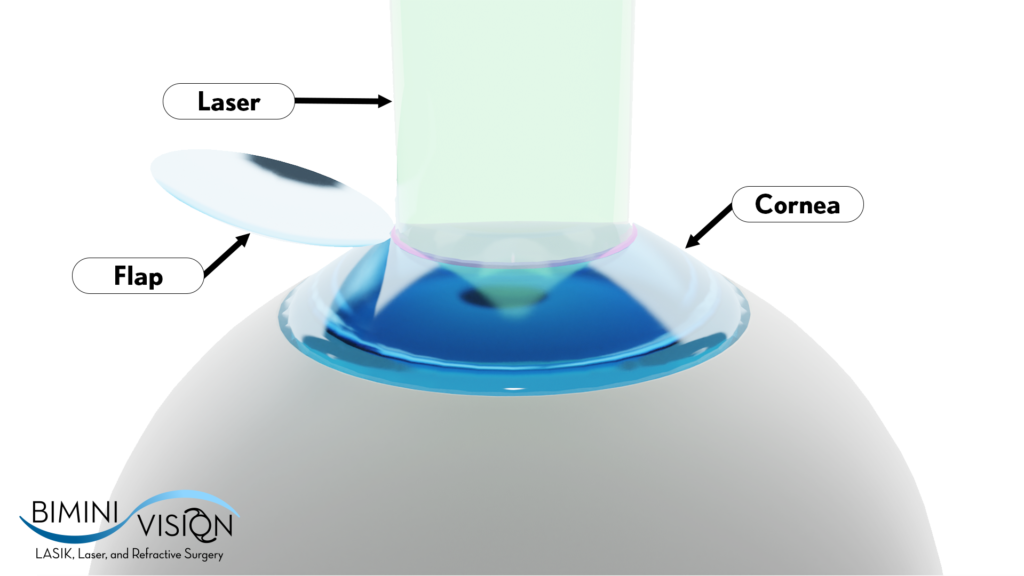
After the procedure, you will have drops to take and will need to take it easy for a week and avoid rubbing or touching your eyes. There may be slight discomfort, worse with PRK, that will improve over the following week. Visual recovery is typically fast. We will need to see you one day, one week, and one month after the procedure. Generally, plan to use the eyedrops 4 times a day for the first week after surgery, 3 times a day for the second week after surgery, 2 times a day for the third week after surgery, and 1 time a day for the fourth week after surgery.
Because LASIK creates a flap in the front of your eye, there is a very, very rare chance of the flap dislocating or experiencing problems if you ever get hit in the eye. Safety glasses are recommended for activities like sports after LASIK.

PRK (Photorefractive Keratectomy) uses a laser to reshape the cornea (the clear, front part of the eye) so it can better focus light onto the retina. The method to accomplish this differs from LASIK. PRK applies the laser through all the frontmost layers of the cornea without a flap.
We take all the measurements we need for any vision correction procedure at your consultation. It’s important to stay out of soft contact lenses for at least five (5) days and three (3) weeks for rigid contact lenses. If you have special contact lenses, let us know when you schedule your consultation. We can operate on the same day as your consultation with proper planning.
We take great care to make sure there is no discomfort at any point of the procedure. A single laser carefully reshapes the cornea. The procedure typically takes under 5 minutes.
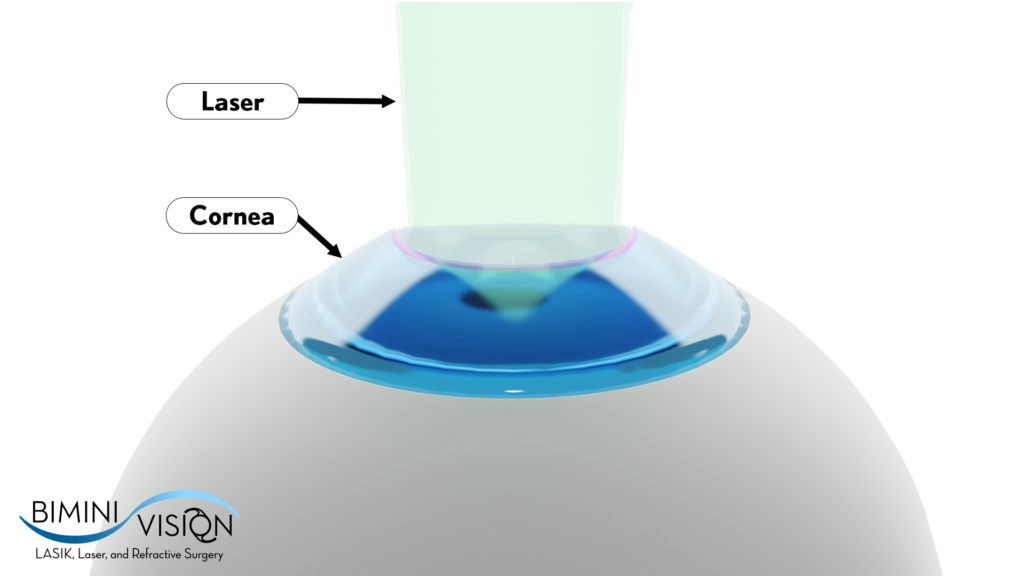
After the procedure, you will have drops to take and will need to take it easy for a week and avoid rubbing or touching your eyes. There may be slight discomfort, worse with PRK, that will improve over the following week. Visual recovery is typically fast. We will need to see you one day, one week, and one month after the procedure. Generally, plan to use the eyedrops 4 times a day for the first week after surgery, 3 times a day for the second week after surgery, 2 times a day for the third week after surgery, and 1 time a day for the fourth week after surgery.
Because PRK does not create a flap, it can be uncomfortable while the eye heals. It may feel like sand or irritation in the eye for the first couple days after the procedure while the eye heals. While the surface of the eye usually heals within the first weak and the irritation subsides, complete healing usually takes around 3 months which is when we’ll be able to tell what your final prescription is.

LALEX (Laser-Assisted Lenticular EXtraction) reshapes the cornea (the clear front part of the eye) using a laser to help it better focus light. Unlike LASIK or PRK, it does this by removing a lens-shaped section of cornea with a different type of laser and only minimally disrupts the surface of the cornea compared to LASIK or PRK. This means the procedure is very comfortable with a very fast visual recovery. LALEX is branded as SMILE or SILK, so you may see these terms as well.
We take all the measurements we need for any vision correction procedure at your consultation. It’s important to stay out of soft contact lenses for at least five (5) days and three (3) weeks for rigid contact lenses. If you have special contact lenses, let us know when you schedule your consultation. We can operate on the same day as your consultation with proper planning.
We take great care to make sure there is no discomfort at any point of the procedure. We use one laser for the entire procedure and carefully remove the section of cornea. The light may go dim at several parts of the procedure. It typically takes under 10 minutes for both eyes.
After the procedure, you will have drops to take and will need to take it easy for a week without touching or rubbing your eyes. We will see you one day, one week, and one month after surgery. Generally, plan to use the eyedrops 4 times a day for the first week after surgery, 3 times a day for the second week after surgery, 2 times a day for the third week after surgery, and 1 time a day for the fourth week after surgery.
LALEX is only approved for the treatment of myopia and astigmatism. It does not create a flap and usually has irritation or discomfort.

Lens Replacement refers to replacing the natural crystalline lens that sits behind the iris (the colored part of the eye). This can be a great option for those wanting to be free from reading glasses, and those with large prescriptions (especially those who are very farsighted). Lens Replacement is essentially cata- ract surgery before cataracts every develop!
We take all the measurements we need for any vision correction proce- dure at your consultation. It’s important to stay out of soft contact lenses for at least five (5) days and three (3) weeks for rigid contact lenses. If you have special contact lenses, let us know when you schedule your consultation.
We take great care to make sure there is no discomfort at any point of the procedure. We first use a laser to perform some steps of the procedure before moving to a different room where the rest of the procedure is performed. We make two very small openings in the cornea (the clear part at the front of the eye), remove the natural crystalline lens, and insert a new lens in the same cap- sule where the old lens was. Both eyes are completed on the same day and the procedure itself usually takes about 15 minutes.
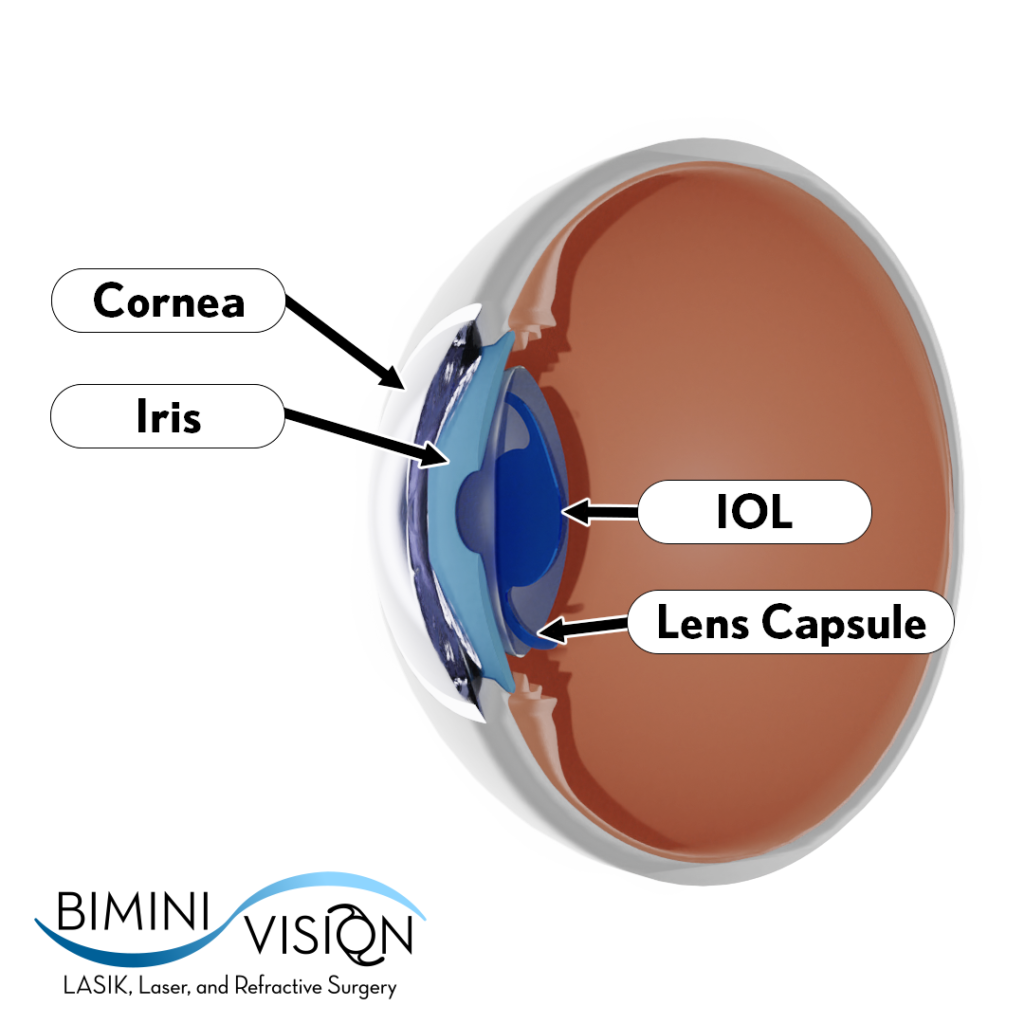
After the procedure, you will have drops to take and will need to take it easy for a week. This means no lifting, straining, submerging your head in water, or touching/rubbing your eyes. We will see you one day, one week, and one month after surgery. Generally, plan to use the eyedrops 4 times a day for the first week after surgery, 3 times a day for the second week after surgery, 2 times a day for the third week after surgery, and 1 time a day for the fourth week after surgery.
Lens replacement is essentially cataract surgery without a cataract. People who have lens replacement never develop a cataract!
Modern Vision Correction is extremely safe and results in excellent outcomes and your surgeons take every measure to minimize the risks. Everything in life does have risks though. Thankfully, the incredible benefits of Vision Correction often outweigh the remote risks. The risks are somewhat different for the surface-based procedures (LASIK, PRK, and LALEX), ICLs, and Lens Replacement. These risks are not a substitute for carefully reading the consent provided by your surgeon.
The rare but serious risks for surface-based procedures include but are not limited to:
The rare but serious risks for ICLs include but are not limited to:
The rare but serious risks for lens replacement include but are not limited to:
These are all so rare that they’re hard to accurately quantify. We provide links to literature (click the blue links above to view the source) to give a rough idea of risk but certain conditions can affect risk. For example, experiencing swelling of the back of the eye is much more common with a history of diabetes. It’s also even more rare that if something happens, an additional surgery cannot recover your vision if addressed in a timely fashion. These problems are also of significantly varying severity. For example, high eye pressure or swelling of some structures frequently resolves quickly with no longterm problems.
We don’t mean to scare you with this information and the overwhelming majority of the time, the surgery takes under 10 minutes with no problems so this should not detract from the excitement of a new life with new vision. We believe in keeping you informed of all facets of this procedure though so it’s important to discuss the risks, no matter how rare.
For each procedure, 20/20 vision and as much freedom from glasses possible is our goal. However, it’s very important to understand that despite the most modern technology, the most advanced equipment, and the very best efforts of your surgeons, there is never a guarantee for 20/20, perfect vision. Even if the refractive target is perfect, something else about your eye might be preventing perfect vision. If you have a pre-existing eye disease (examples include but are not limited to history of a “lazy eye” as a child or a problem with the retina), your eye might not be capable of seeing 20/20. Before surgery, we screen for several diseases that could limit the vision but it’s important to talk to your surgeon about your best visual potential and continue regular and routine eyecare. Despite all the advances of modern medicine, in rare cases healing can also be unpredictable but rest assured, we will be with you every step of the way.
The purpose of your consultation is to carefully examine your eyes and choose the procedure that minimizes risk and maximizes your vision and comfort. To use an analogy, a skilled pilot can fly in a wide variety of weather conditions but sometimes it’s safer to not fly at all. In extremely rare circumstances, vision correction might not be possible with current technology but these situations are very unusual.
Correcting your vision using lasers may not be ideal if you have certain autoimmune diseases (e.g., lupus, rheumatoid arthritis), immunodeficiency states (e.g., HIV) and/or diabetes. Some medications (e.g., retinoic acid and steroids) also may limit the use of lasers.
Your prescription may change while pregnant so pregnancy is also not a goo dtime for vision correction.
This is a lot of information and we hope you find it helpful. It’s very, very important to talk to your surgeon about your specific situation as nothing on this website constitutes medical advice nor is a substitute for professional medical advice, diagnosis, or treatment. Remember, every eye is unique and only you and your surgeon know your eyes and the exact care they require. You can find a summary of this information in your Cataract Surgery packet and we’ll be ready to answer any questions you have when we meet!
Information shared on Bimini.Vision or BiminiVision.com and all of its pages (“Website”) are for general informational and educational purposes only. This Website and its contents are not intended to provide medical, business, and/or legal advice or to serve as a substitute for professional services, including but not limited to advice, diagnosis, and treatment. Nothing should be construed herein as making or creating a doctor-patient relationship. Emergency support is not available through this website; if you have an emergency, please call 911 or go to your local emergency services. The Website creators, authors, and Bimini Vision assume no liability for any loss, damage, or harm resulting directly or indirectly from participation, visitation, joining, use, and/or viewing the Website and are not responsible for any decisions visitors make based on the information provided on the Website. Visitors will indemnify, defend, and hold harmless Bimini Vision against any damages, losses, liabilities, judgments, costs or expenses (including reasonable attorneys’ fees and costs) arising out of a claim by a third party relating to any material on the Website. In no event will Bimini Vision and/or the Website authors be liable to any person or party visiting, viewing, and/or participating with this Website for any direct, indirect, special, consequential or other damages, or be subject to any other legal remedy, if such damages and/or remedy is allowed under any theory of law (such theories of law include, but are not limited to, any legal action brought under express or implied warranty, contract, strict liability or tort (including negligence or otherwise)), even if the same are expressly advised of the possibility of such damages and/or other legal remedy. Visitors are responsible for their own health and well-being and should consult with a qualified healthcare professional before making any changes to their health or treatment plan. Specific medical advice can only be provided by a visitor’s physician; visitors should not delay seeking the advice of their physician or other qualified healthcare provider. Any participation, visitation, and/or viewing of this Website constitutes acceptance of these Terms and an acknowledgment that you have read and agreed to these Terms; if you do not accept these Terms, do not view, participate, visit, and/or use the Website.
Have a question before we get started? Let us know and we’ll reach out!
Join our mailing list and be the first to hear about our progress creating Bimini Vision.